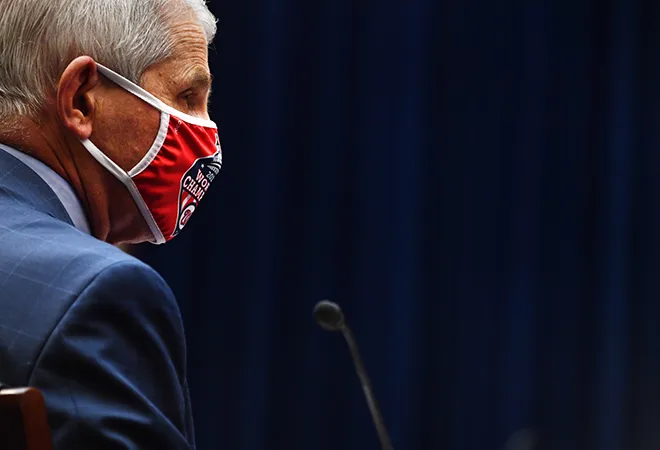
Nearly eight full months after the US recorded its first coronavirus case on the country’s west coast, the alarm bells are still going off. More than 170,000 Americans are dead and more than five million have been sickened by this extraordinary virus, in which 40% of individuals have no symptoms at all. The US outbreak is a cautionary tale, it tells us that the world’s wealthiest country has bungled its public health and political response. To understand how we got here, we parsed through a trove of webinars headlined by America’s top infectious diseases expert, Anthony Fauci, and came up with six dominant themes that, together, tell the tale of America’s disastrous state of play and answer some of the most urgent questions Americans are asking. When the definitive story of the US response is finally written, the Fauci lens will be a crucial one. As we look to science to save us, we piece together how the senior-most epidemiologist on the White House coronavirus task force understands the pandemic in terms of reopening the economy, reopening schools, vaccine efficacy, universal masking and societal responsibility. We bring you six highlights, informed by Fauci’s most consequential remarks on each one. From what Fauci calls “sad, past experience,” latest data reveal that new surges are still coming.
When the definitive story of the US response is finally written, the Fauci lens will be a crucial one.
America’s baseline flattening “unacceptable”
First, America did not ever allow the infection curve to fully flatten out before it reopened. The baseline of around 20,000 total cases per day (when states began reopening) was “unacceptable,” says Fauci. Quite soon, the daily caseload hit a peak of over 70,000. Americans, according to him, did not collectively do the “five or six things” that, at a minimum, could have prevented the alarming surges that have made America’s graph careen off the charts. Those five or six things are wearing masks, washing hands, avoiding crowds, preferring outdoors over indoors and practicing social distancing. Fauci compares the American idea of “baseline” with stricter definitions in Europe and elsewhere, where countries came all the way down before they reopened. “Bottom line is, I'm not pleased with how things are going,” Fauci said in a conversation with National Geographic on 13 August, nearly eight months after the virus arrived on US shores. Pushed on the question of how America has fared relative to the rest of the world, Fauci agreed, during a Harvard webinar, that it was the worst. “As long as you have any member of society, any demographic group, who is not seriously trying to get to the endgame of suppressing this, it will continue to smoulder and smoulder and smoulder,” Fauci said. “And that will be the reason why, we’ve plateaued at an unacceptable level.”
50 states pulling in different directions
Second, Fauci points to the now-ubiquitous pictures of maskless people at crowded beaches, bars and parties to examine how American society across 50 states has steadfastly refused to pull in the same direction. He describes the divergence of attitudes as “unfortunate” — where people say either lock down completely or “let it rip.” The spirit of freedom that is at the core of American culture has also been its undoing during a public health emergency. According to Fauci, a “golden mean” would have been just enough to open the country safely. “You know we like authority, but we don't like authority. That's getting us into trouble and that's what I think the complexity of all of this is founded in, that inconsistency of what we’re doing.” That inconsistency extends to testing. We’re in August and the US still doesn’t have rapid testing at scale. “The gap between the time you get the test and the time you get the result, in some respects, obviates the reason why you did the test.”
The spirit of freedom that is at the core of American culture has also been its undoing during a public health emergency.
“Cavalier” attitude is killing people
Third, as super-spreader events continue to make headlines, Fauci is urging young Americans to understand that they’re part of a chain and that they do not operate in a vacuum. Although the data show that the young do much better in terms of outcomes, Fauci has been drawing attention to how “cavalier” attitudes are “killing some people” because the young may be innocently propagating an outbreak thinking they are not affecting anybody. “You get infected and what happens is that almost certainly you or your friends and colleagues will infect someone else, who will infect someone else and then someone is going to get seriously ill, and maybe die. That could be someone's mother, their father or immuno-compromised child. So, you've got to appreciate that not only do you have an individual responsibility to yourself; you have a societal responsibility to help us all.”
Would gladly accept a vaccine with 55-75% effectiveness
Fourth, Fauci is hoping for a vaccine that’s “60-70-75%” effective but says he will gladly accept a vaccine with 55% effectiveness. Fauci thinks the coronavirus vaccine’s effectiveness, at least in the immediate race for a remedy, will not be up there with, say, a measles vaccine which is 97-98% effective. We should think of the vaccine as a “very helpful, and a very important additional tool” in combination with public health guidance already in place, according to Fauci. He remains “cautiously optimistic” that a vaccine will be ready by early next year. More than a quarter-million Americans have already volunteered to take part in clinical trials. America has had a fairly standard way of deciding how to distribute the vaccine first, especially when it is a scarce intervention in the early months of its arrival. This time, we have learnt over several iterations of Fauci’s testimonies that the Advisory Committee on Immunization Practices, which advises the CDC, will have a few more layers in the form of ethicists, biologists and vaccinologists to look at the prioritisation decisions.
America has had a fairly standard way of deciding how to distribute the vaccine first, especially when it is a scarce intervention in the early months of its arrival.
Reopening schools: States should not take “all-or-nothing approach”
Fifth, with Fall term almost upon us, the risks associated with decisions around school reopening are consuming Americans. For weeks, Trump has been pushing the view that kids don’t catch COVID-19 easily and that they don’t bring it home easily. And, even if they do catch it, they get better faster than other age groups. After all the grandstanding from the White House, school boards have been left to untangle the mess. Fauci maintains that places with low virus levels should be allowed to open for in-person classes, while those with higher case counts should focus on remote learning until the infection rate declines. “Get as much outdoors as you can. If you look at the super-spreader events that have occurred, they’re almost always inside,” he said, citing major outbreaks at nursing homes, meatpacking warehouses, prisons, as well as weddings and other social events. “If you want to open schools, do what you need to do,” Fauci said. “Close the bars. Wear your masks. Because when you do that, you will bring the infections down.”
We don’t know enough about airborne spread
Masks work in flattening the curve, they also work because we simply don’t know enough about airborne spread of the coronavirus. That’s what we are hearing from Fauci in mid-August. Fauci, who’s long been pushing Americans to adhere to six feet distancing is now asking an open question to other scientists who make a living off particle physics and aerosolisation: If you have a virus that's less than five micrometers, could you then have the phenomenon of a “floating” coronavirus? “You know, you really better take a bigger look at this. Because from what we know about particle physics and air flows, there may be droplets much larger than five micrometers that continue to go around, which means it gives you some pause to think about, do we know what to do and should we investigate and make some changes?” All this, Fauci explains, just gives us more reason to wear a mask at all times. It also tells you that being outdoors is better than indoors and keeping windows open could really be a great hack. If aerosol does play a bigger role than what we currently know, that puts even greater premium on all the social distancing 101s that the world has learnt in 2020: “You've got to wear a mask, avoid crowds, outdoor better than indoor — all the same stuff.”
The views expressed above belong to the author(s). ORF research and analyses now available on Telegram! Click here to access our curated content — blogs, longforms and interviews.




 PREV
PREV


